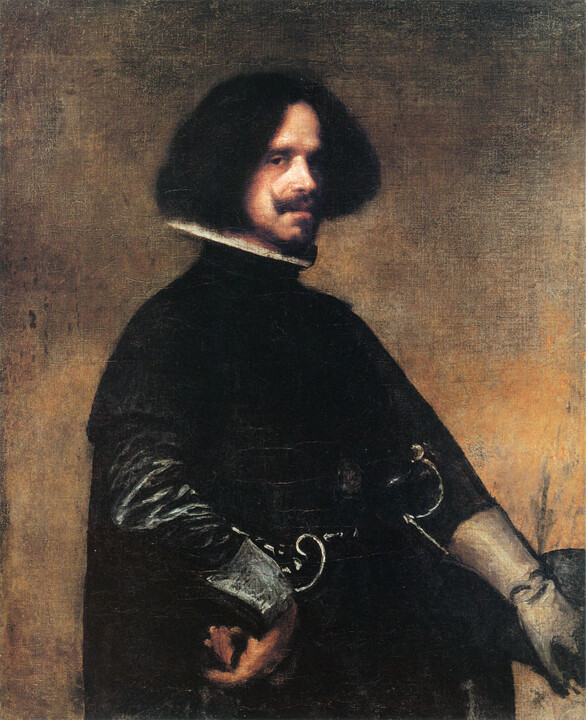 Diego Velázquez, Self-portrait, c. 1645. Oil on canvas, 1 035 x 825 mm. Florence: Uffizi Gallery.
Diego Velázquez, Self-portrait, c. 1645. Oil on canvas, 1 035 x 825 mm. Florence: Uffizi Gallery.
Who was Diego Velázquez?
Diego Velázquez was a Spanish painter who lived from 1599 to 1660. He is considered one of the most important painters of the Spanish Golden Age and is known for his portraits, genre scenes, and historical paintings. Velázquez began his career in Seville, where he trained under Francisco Pacheco. In 1622, he moved to Madrid and became the court painter to King Philip IV. Velázquez's portraits of the king and other members of the Spanish court are among his most famous works. Velázquez's style was characterized by his use of light and shadow, his ability to capture the individual character of his subjects, and his attention to detail. He was also a master of composition, and his works often feature complex arrangements of figures and objects. Some of Velázquez's most famous works include "Las Meninas," "The Surrender of Breda," and "The Rokeby Venus." His influence on later painters, including Manet and Picasso, was significant, and his work continues to be admired and studied today.
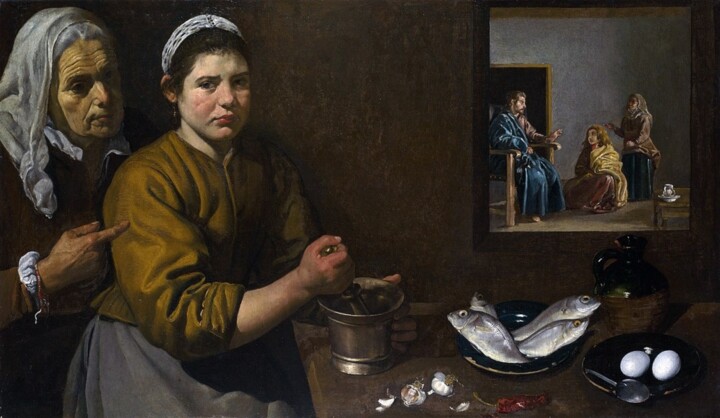 Diego Velázquez, Christ in the House of Martha and Mary, 1618. Oil on canvas, 63 cm × 103.5 cm. London: National Gallery.
Diego Velázquez, Christ in the House of Martha and Mary, 1618. Oil on canvas, 63 cm × 103.5 cm. London: National Gallery.
What are five stylistic characteristics of Diego Velázquez?
- Realism: Velázquez was renowned for his ability to create highly realistic and lifelike portraits. He used a technique known as "tenebrism" to create a sense of depth and three-dimensionality in his works.
- Use of light: Velázquez was a master of using light to create drama and highlight the main subjects of his paintings. He often used strong contrasts between light and dark to create a sense of depth and perspective.
- Loose brushwork: Despite his attention to detail and realism, Velázquez often used loose and fluid brushstrokes in his work. This gave his paintings a sense of movement and energy.
- Minimalism: Velázquez often employed a minimalist approach to composition, using simple backgrounds and muted colors to keep the focus on his subjects. He also used negative space to create a sense of balance and harmony.
- Psychological insight: Velázquez was known for his ability to capture the inner character and emotional state of his subjects. His portraits often show a deep understanding of the human psyche, and he was particularly skilled at conveying complex emotions through facial expressions and body language.
 Diego Velázquez, Las meninas, c. 1656. Oil on canvas, 318×276 cm. Madrid: Museo del Prado.
Diego Velázquez, Las meninas, c. 1656. Oil on canvas, 318×276 cm. Madrid: Museo del Prado.
Las Meninas
"Las Meninas" is a famous painting by the Spanish artist Diego Velázquez. Completed in 1656, it depicts a scene in the court of King Philip IV of Spain, with the king and queen reflected in a mirror in the background. The painting is renowned for its intricate composition, use of light and shadow, and its ambiguous portrayal of reality. At the center of the painting is a young princess, Infanta Margarita, surrounded by her ladies-in-waiting, or "meninas" in Spanish. Velázquez himself appears in the painting, standing at a canvas and holding a brush, suggesting that he is capturing the scene we see before us. The painting has been interpreted in many ways, with some suggesting that it is a meditation on the nature of art itself, and others seeing it as a reflection on the role of the artist in society. "Las Meninas" is widely regarded as one of the greatest paintings of all time, and is a masterpiece of the Spanish Golden Age. It can be seen today in the Museo del Prado in Madrid, where it remains one of the museum's most prized possessions.
The main characters in the artwork
 Diego Velázquez, The Infanta Margarita in Blue, 1659. Oil on canvas, 127×107 cm. Vienna: Kunsthistorisches Museum.
Diego Velázquez, The Infanta Margarita in Blue, 1659. Oil on canvas, 127×107 cm. Vienna: Kunsthistorisches Museum.
Infanta Margaret Theresa
Infanta Margaret Theresa was a Spanish princess who lived in the 17th century. She was the daughter of King Philip IV of Spain and his second wife, Mariana of Austria. Margaret Theresa was born in 1651 and was the eldest surviving child of the couple. As a child, Margaret Theresa was considered a valuable pawn in the political alliances of the time, and at the age of five, she was betrothed to her uncle, Leopold I, Holy Roman Emperor. The marriage was intended to cement the alliance between Spain and Austria. Margaret Theresa was raised in a strict environment and received a comprehensive education, which included religious instruction, music, painting, and dancing. She was known for her beauty and intelligence and was fluent in several languages. Margaret Theresa's marriage to Leopold I was eventually consummated, and she gave birth to four children, including two sons who would later become Holy Roman Emperors. However, her life was cut short when she died at the age of 21 in 1673, possibly due to complications from childbirth. Despite her short life, Margaret Theresa's legacy lived on through her children, and her beauty and intelligence were celebrated in art and literature. She is remembered as a symbol of the political alliances and dynastic ambitions of 17th-century Europe. As for Las Meninas, L'Infanta is the blond child to whom Maria Augustina Sarmiento and Isabel de Velasco turn their attentions.
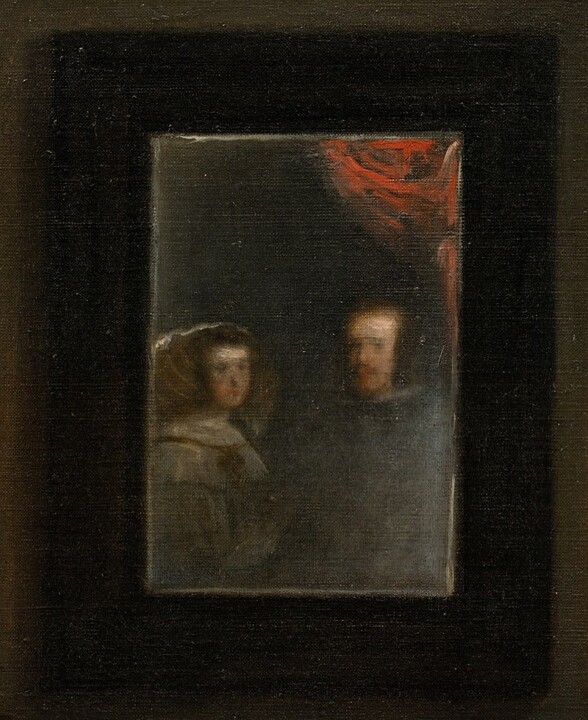 King Philip IV and Mariana of Austria detail of Las Meninas.
King Philip IV and Mariana of Austria detail of Las Meninas.
King Philip IV and Mariana of Austria
King Philip IV of Spain, also known as Felipe IV in Spanish, was the King of Spain and Portugal from 1621 until his death in 1665. He was born on April 8, 1605, in Valladolid, Spain, and was the son of Philip III of Spain and Margaret of Austria. Mariana of Austria, also known as Mariana of Austria the Younger, was the Queen consort of Spain from 1646 to 1665, as the wife of King Philip IV. She was born on December 24, 1634, in Wiener Neustadt, Austria, and was the daughter of Emperor Ferdinand III and Maria Anna of Spain. As for Las Meninas, the rulers appear immortalized in a mirror.
José Nieto
José Nieto Velázquez was the queen's chamberlain during the 1650s, apart from Las Meninas, Velazquez painted a portrait of José Nieto. The portrait, titled Portrait of a man and c. 1635-45, is currently in the Apsley House, London. As for Las Meninas, José is the character depicted on the stairs.

Marcela de Ulloa
When Marcela de Ulloa remained the widow of Diego de Peralta Portocarrero, Marquis of Almenara, she first entered the service of the Countess of Olivares and later joined the Royal Palace, where she became head maid and in charge of the care of Infanta Margarita Teresa of Austria. In Velazquez's masterpiece Marcela wears mourning clothes while and chats with an unidentified figure.

Maria Augustina Sarmiento
María Agustina Sarmiento de Sotomayor, one of the meninas de la infanta Margarita de Austria and daughter of Diego Sarmiento de Sotomayor, appears, in Velazquez's masterpiece, kneeling before Maria Teresa, while, at the same time, appearing to offer her something to drink on a tray.
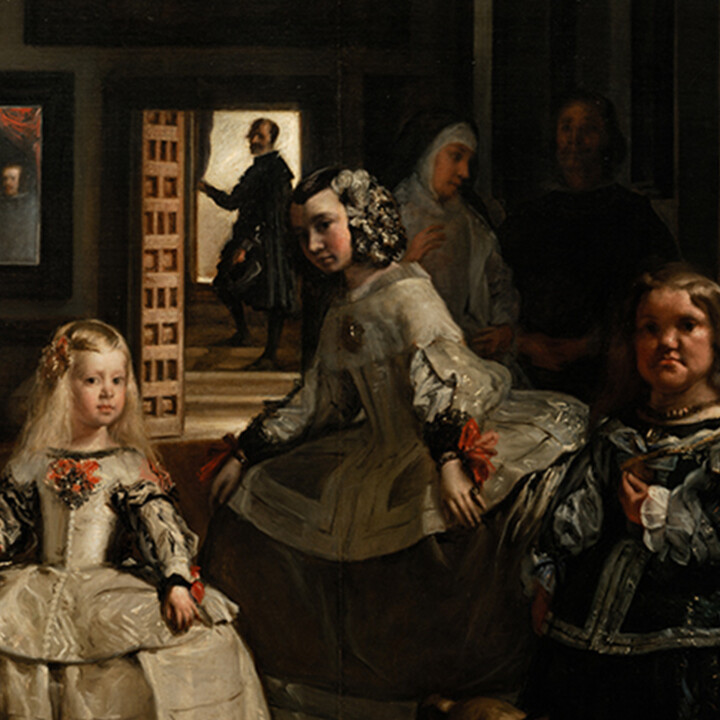
Isabel de Velasco
Isabel de Velasco, daughter of Bernardino López de Ayala y Velasco, 7th Count of Fuensalida and 1st Count of Colmenar de Oreja, by his first wife Isabel de Velasco y Benavides, entered the service of the Royal Palace at the age of 11 as a menin of Queen Mariana of Austria, whom she served from December 26, 1649 until her death on October 22, 1659. In Las Meninas, Isabel stands to the left of the young princess Margaret Theresa, and is caught in a position that makes it clear to us that she is ready to bow.
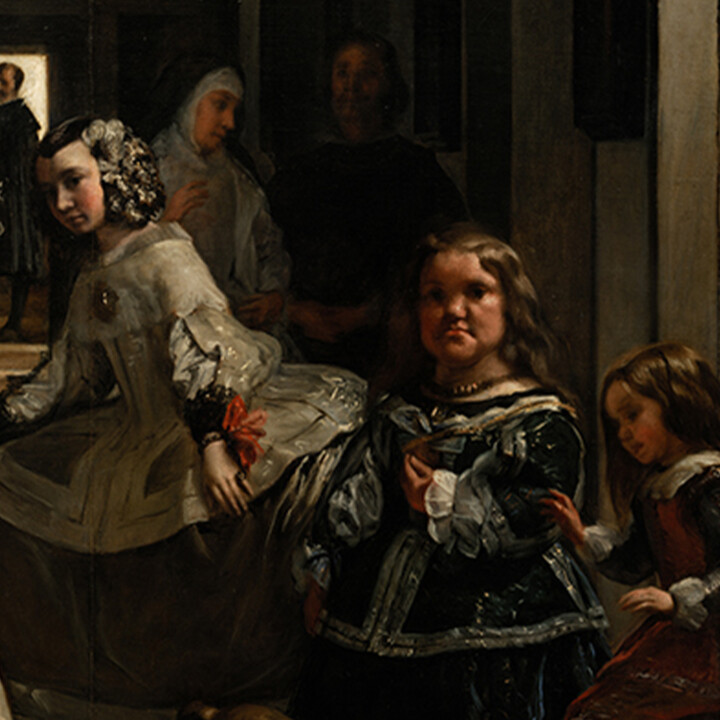
Maria Barbola and Nicolasito Pertusato
The German Bárbola and the Italian Pertusato are the two dwarfs who find placement on the right side of the canvas. They played an important role in Philip's court; in fact, they were portrayed numerous times by Velázquez.

Diego Velázquez
The Spanish painter shows himself in front of a canvas, working on a portrait of the royal couple. The Spanish painter shows himself in front of a canvas, working on a portrait of the royal couple. He takes placement on the left side of the canvas, showing confidence in his role as an artist.
Meanings
The painting has been the subject of much debate and analysis over the years, with various interpretations put forward by art historians and critics. Some suggest that the painting is a representation of the role of the artist in society, while others see it as a commentary on the power dynamics of the Spanish court. One interpretation is that the painting is a reflection of Velázquez's position as court painter and his relationship with the royal family. The artist appears in the painting as a shadowy figure in the background, holding his palette and brushes. This has led some to speculate that the painting is a self-portrait, with Velázquez using the reflection in a mirror to depict himself. Another interpretation is that the painting is an exploration of the nature of perception and representation. The complex arrangement of figures in the painting, with the viewer's eye drawn to different points of interest, has led some to suggest that Velázquez is playing with the viewer's sense of perspective and inviting them to question what they see.
Pigments
Diego Velázquez's use of pigments in "Las Meninas" is not well-documented, and it's difficult to determine the exact pigments he used in the painting. However, it is believed that he likely used a range of pigments commonly used by artists of his time. During the 17th century, the pigments commonly used by artists included natural pigments such as ochre, sienna, and umber, as well as synthetic pigments such as lead-tin yellow, vermilion, and ultramarine blue. Velázquez would have had access to a wide range of pigments, as he was the court painter for King Philip IV of Spain. Some art historians have speculated that Velázquez may have used lead white, lead-tin yellow, red lead, vermilion, and carbon black in "Las Meninas". The use of these pigments would have allowed Velázquez to achieve the strong contrasts and vivid colors that are characteristic of the painting.
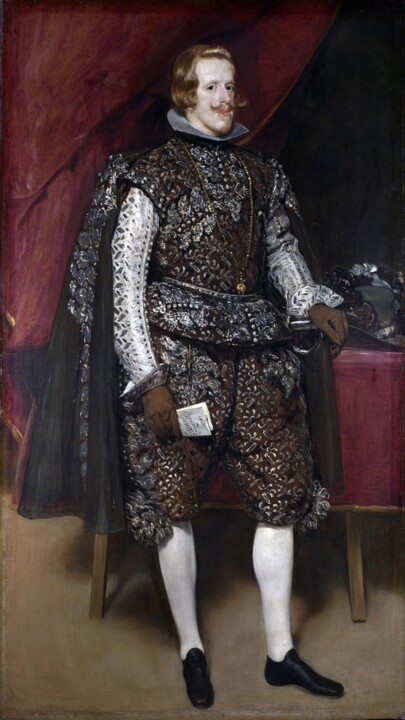 Diego Velázquez, Philip IV, c. 1631. Oil on canvas, 195×110 cm. London: National Gallery.
Diego Velázquez, Philip IV, c. 1631. Oil on canvas, 195×110 cm. London: National Gallery.
Court of Philip IV
Velázquez's relationship with the court was a close one, and he was highly respected for his artistic abilities. He was granted many privileges by the king, including a salary and living quarters in the palace. Velázquez also had access to the royal collections, which allowed him to study and be inspired by the works of other great artists. During his time as court painter, Velázquez created many portraits of the royal family, including King Philip IV himself. He was known for his ability to capture the personality and character of his subjects, as well as for his use of light and shadow to create depth and realism in his paintings. Overall, Velázquez's position as court painter allowed him to create some of the most iconic works of art of the 17th century, and his legacy continues to be celebrated to this day.
Key points and curiosity
- The painting is also known as "The Maids of Honour." The term "meninas" refers to the ladies-in-waiting or maids of honour who are depicted in the painting.
- The painting is considered one of the greatest masterpieces of Spanish art, and it is housed in the Prado Museum in Madrid.
- The painting is a complex composition that includes multiple figures and layers of space. The viewer is positioned in the foreground, looking into a large room where the princess and her entourage are situated. Velázquez is also depicted in the painting, standing behind an easel and appearing to be painting the scene we see.
- The painting has been the subject of much interpretation and analysis over the years. Some have suggested that the painting is a commentary on the role of the artist in society, while others have seen it as a representation of the power dynamics within the Spanish court.
- The painting has been influential in the world of art, inspiring many other artists over the years. Pablo Picasso, for example, painted a series of variations on the theme of "Las Meninas" in the 1950s.


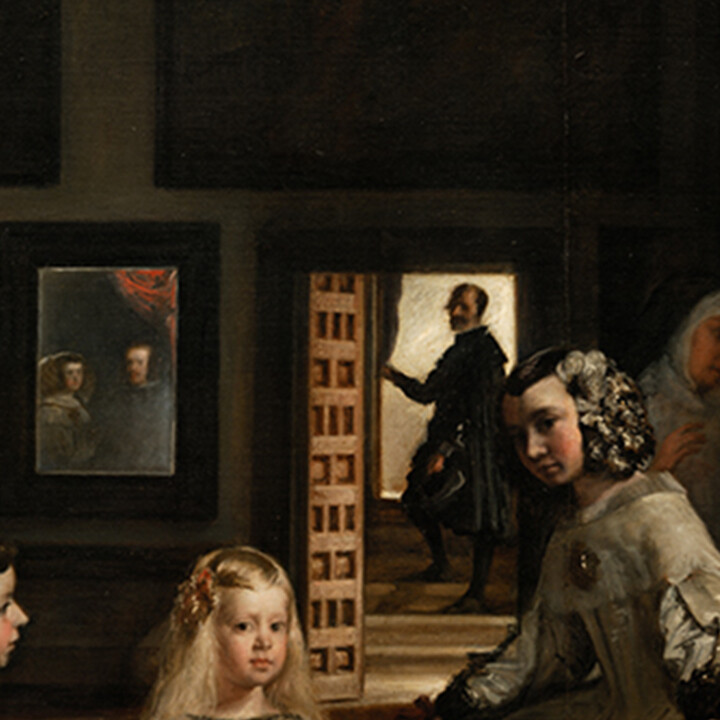
 Selena Mattei
Selena Mattei





